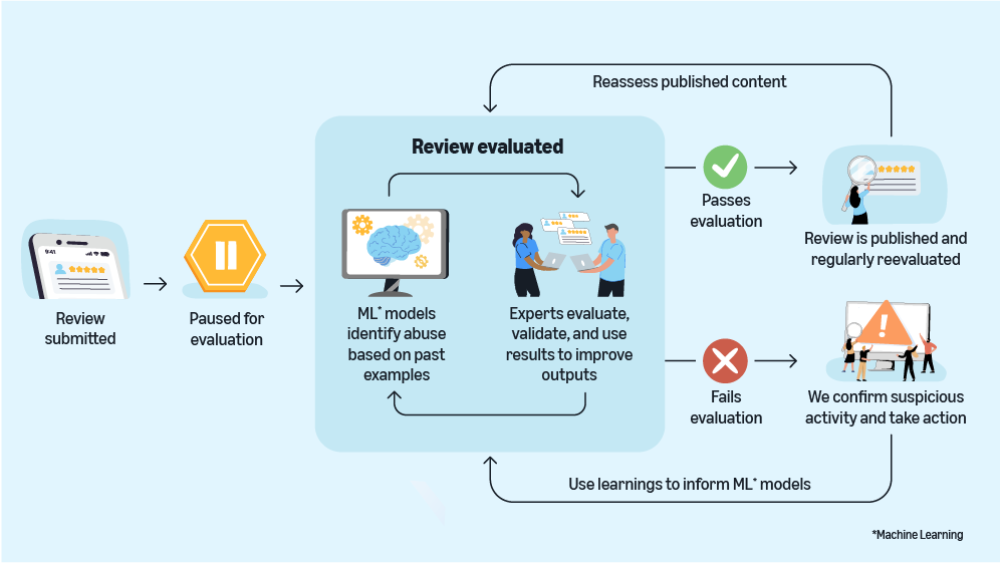
Behind the scenes: How Amazon maintains a trusted review experience
Product reviews are central to Amazon’s shopping experience. Since we pioneered this feature in 1995, potential customers have been able to get relevant, firsthand feedback on items when deciding what and whether to buy. Whether 1-star, 5-star, or anything in between, authentic reviews give our customers valuable feedback on purchasing decisions and help selling partners refine their products. Today, reviews are common across multiple industries, and, in 2023, more than 100 million customers contributed one or more reviews or ratings to Amazon’s store.
Over the years, we have regularly added new features to improve the reviews experience for customers and selling partners. These include one-tap reviews, review-sharing across countries, and multimedia reviews, that give customers additional context to help them with their purchasing decision. Our reviews are now available in over 20 different languages so customers around the world can benefit from other’s feedback.
Customers trust that they can come to Amazon for genuine review information. We invest substantial resources to stop fake reviews and the bad actors who knowingly conduct illegal activity intended to deceive customers and harm the small businesses selling in Amazon’s store.
Let’s take a deeper look behind the scenes into how Amazon keeps fake reviews out of our store by having high standards and clear guidelines, proactively detecting and preventing fake reviews, and holding bad actors accountable.
- A review by someone who has a direct or indirect financial interest in the product.
- A review by someone perceived to have a close personal relationship with the product’s owner, author, or artist.
- A review by the product manufacturer, posing as an unbiased shopper.
- Multiple negative reviews for the same product from one customer.
- A review in exchange for monetary reward.
- A review of a game in exchange for bonus in-game credits.
- A negative review from a seller on a competitor’s product.
- A positive review from an artist on a peer’s album in exchange for receiving a positive review from them.
Amazon invites customers to leave reviews independent of whether their experience was positive or negative. Transparency around reviews is core to our approach on reviews, and we have clear and easily accessible policies in place about who can leave a review, the review content that we allow, and our stance against fake reviews. We also prohibit other content that makes the community less safe, trustworthy, or helpful. Examples of prohibited content include: hate speech, profanity, harassment, spam, and promotional content. Our community guidelines provide clear consequences for reviewers that violate our policies including limiting the ability to submit reviews or even suspending their account.
Once posted, only the person who wrote the review can edit it and only Amazon can suppress it, which we do only when the review fails to meet the standards of integrity outlined in our guidelines and review policies. We work with selling partners to educate them about what’s permitted in our store, including Amazon’s policies prohibiting fake reviews, review manipulation, and otherwise protecting the trustworthiness of our reviews. Selling partners cannot offer compensation in exchange for a positive or negative review and neither Amazon nor selling partners can edit, or ask customers to edit, or remove a review. When a reviewer submits a review for a product they purchased, the review is identified with a ‘Verified Purchase’ badge. This helps customers identify reviews by other customers that bought the product from the Amazon store, compared to others who may have purchased the product elsewhere. The review is validated by Amazon, where we check if the review bought the item on Amazon and paid a price available to most Amazon shoppers. If we confirm both, we label the review as Verified Purchase.
To keep Amazon’s reviews trustworthy, Amazon starts by leveraging technology behind the scenes. We analyze 100% of product reviews before they are posted using both advanced machine learning models and expert human investigators. We use the latest advancements in AI to stop hundreds of millions of suspected fake online reviews, manipulated ratings, fake customer accounts, and other abuses before customers see them.
How we prevent, detect, and block fake reviews
“Our sophisticated machine learning methods help Amazon go well beyond surface-level information to uncover hidden differences between authentic and fake reviews,” said Josh Meek, senior data science manager on Amazon’s Selling Partner Trust and Store Integrity team in the video, ‘The science behind keeping fake reviews off Amazon’s store’. “When a customer clicks ‘Write Review,’ machine learning models immediately begin assessing the authenticity of the review based off a multitude of data points stemming from over 25 years of review knowledge. These models analyze proprietary data, including ties to other accounts, customer-submitted reports of abuse, risky behavioral patterns, review history, sign-in activity, and other indications of unusual behavior.”
Our teams leverage large language models, natural language processing techniques, and other machine learning models to analyze data anomalies that might indicate that a review was incentivized with a gift card, free product, or other form of reimbursement. Deep graph neural networks analyze and understand complex relationships and patterns to help detect and remove bad actors or flag suspicious activity for further investigation.
Through our efforts to proactively detect and prevent fake reviews, we sometimes uncover new types of attempted abuse and use that information to improve our detection methods. If customers suspect a review is fake or otherwise violates or Community Guidelines, we urge them to report it to us immediately by using the ‘Report abuse’ link next to the suspicious review on the product listing page. Customers can also report abusive behavior on our report review compensation page (requires signing in to Amazon). They should report abuse if they are offered compensation in exchange for creating a fake positive or negative review, editing reviews, or removing reviews. We investigate all reported reviews and take action as appropriate. We then use the information we gather in these investigations to invest in methods that help our teams analyze and detect these abuses faster and at scale.
Over 99% of the products viewed by customers in our store have only authentic reviews. But we are not stopping there. We continue to build effective and innovative tools and leverage expert investigators to prevent fake reviews and hold bad actors accountable.
- Revoking a customer’s review permissions
- Suspending Amazon privileges
- Withholding or forfeiting remittances and payments
- Blocking bad actor accounts
- Litigating against the parties involved
We will continue to remove reviews that violate our policies while pursuing the bad actors who create demand for fraudulent reviews and supply fraudulent reviews through all available means. A key focus is taking legal action against fake review brokers who portray themselves as legitimate businesses and approach customers directly through websites, social media channels, and encrypted messaging services, soliciting them to write fake reviews in exchange for money, free products, or other incentives. We pursue lawsuits against these brokers, those who commit review abuse, and the people who post those reviews. These lawsuits have provided us data we need to take additional enforcement action against others. In 2015, Amazon filed our first lawsuit against fake review brokers. Since then, we established global teams of lawyers, expert investigators, and analysts to continue stop bad actors at the source. In 2023 alone, Amazon took legal action against more than 150 bad actors in the U.S., China, and Europe. As a result, 75 fake review brokers and related websites have been taken down as of June 2024.
We know customers rely on reviews when shopping on Amazon. The policies, technology, and tactics we have in place help us deliver the authentic reviews experience our customers have come to expect - one where they can be confident knowing that they can trust, and find value in, the reviews that they read. While we have made a great deal of progress, we remain committed to continued innovation to enhance our proactive controls, and work hard to hold bad actors accountable when they engage in abusing reviews to ensure a trustworthy reviews experience.
For more on Amazon’s approach to reviews, visit our Trustworthy Reviews page.




